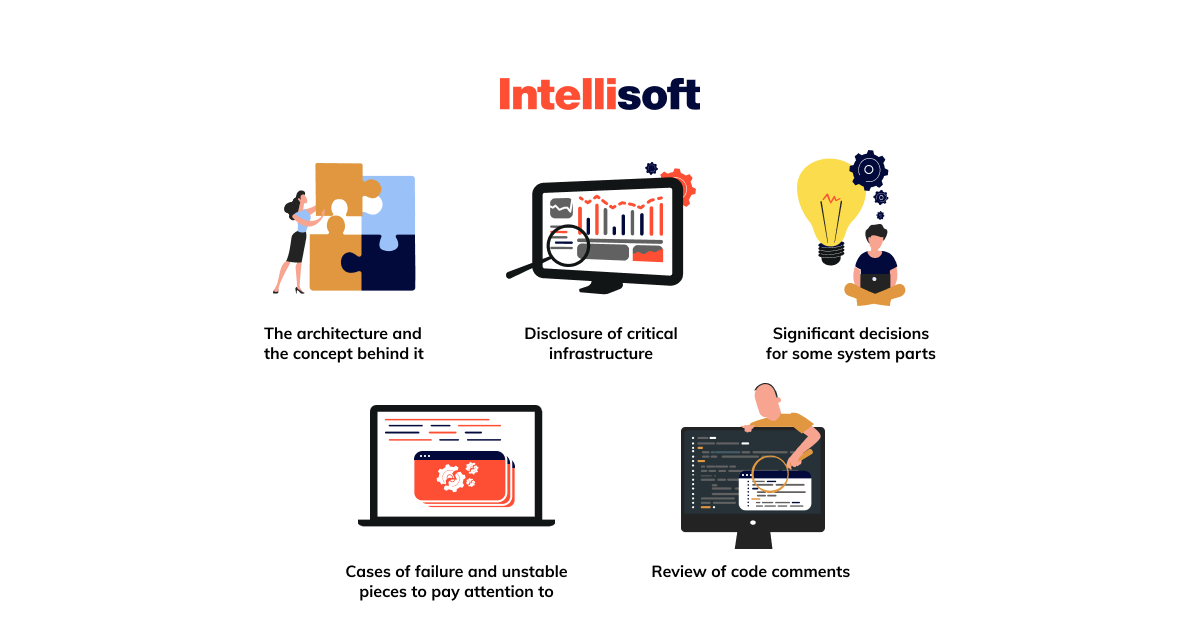Has your project revolutionized from a minimum viable product (MVP) to the scaled version with pro features? Changes may be pretty frightening or stressful for you as a business owner or CTO. They may result in a waste of time and difficulties for new developers in adopting a project. Maybe, you already feel you should switch to a new development team though the work on your project is not over.
Does it seem at least vaguely familiar? For a good reason, 80% of logistics leaders increased their outsourcing budget by more than 5% in 2020-21. It makes sense to follow their example, especially when you need help at any project stage.
Keep reading this new post by Intellisoft to identify when and how to change a development team to ensure an easy and smooth transition.
Table of Contents
Why Do Some Software Projects Fail?
According to the Pulse of the Profession report, project outcomes are rising compared to previous years thanks to enhanced outsourcing practices, remaining at 33% growth as not all companies see their benefits. One-third of software development projects crash and lose budget; another third experience scope creep. As you may guess, only the rest of them succeed with no to little obstacles.

Businesses may be facing various challenges while working on software development projects. Unfortunately, companies can’t cope with some of them. So, what are the most common reasons for a project’s failure?
Reason #1: Suboptimal Performance of Developers
It happens due to the lack of required expertise, experience, poor management, incentive system, and low corporate culture and integration level.
Reason #2: Inferior Coordination of a Project Manager (PM)
Staff is not motivated, experienced, punctual – simply said, not the right person for you.
Check some reasons that may be within your responsibility.
- The lack of internal (inside your company) or external (with your vendor) communication can lead to project failure. The quality of communication often depends on the country where you outsource your project.
- You don’t keep an eye on the ball. Regular progress reviews help check benchmarks and certain phases and keep your project on track.
- Don’t forget about such a psychological factor as resistance to change. We all feel stressed when we leave our comfort zone, facing innovations, development, or expansion challenges.
- Vague vision, requirements, and expectations can disorient anyone. You can’t succeed if you don’t know where you are going.
- Exaggerated expectations mean disappointment. Be realistic, check market rates, do some research to balance your allocated budget and time with expectations.
- A project manager is a key person. They are one of the main contributors to your project’s success. Choose a PM with experience exactly in your domain.
- Digitalization for the sake of digitalization is not working. Projects with significant meaning and value for clients or businesses are more likely to succeed.
- Are you postponing and delaying your projects? Do you often move your goalposts? Are you somewhat flexible or relaxed with the schedule? It works against you. Stick to your program, be punctual, strict, and demanding.
- You didn’t allocate enough time and budget to the project, which resulted in a poor-quality product.
- Your vendor promised too much but under-delivered. He did it on purpose to win the deal. His broken commitments will turn into your disappointment.
- To make your requirements sharp, time and budget estimations easy, use special tools like Specstimate.
If you find yourself in any of these situations, take measures to turn your project back on track. Whether you are a business or product owner, a CTO, or a responsible manager, consider these issues and take action.
Related readings:
How to Hire an IoT Developer: IoT Developer Salary And Job Description
CTO-As-a-Service: The Ultimate Guide
Vendor Management IT. Definition, Features, Advantages, and More
Hire Python Developers Full-Time or Part-Time: Hints from Experts
Hire PHP Developers Full-Time or Part-Time: Hints from Experts
When Is It High Time to Pass the Torch?
Decision-makers should analyze several factors before modifying the team. In some cases, changing equipment and tools might be enough, while, in other cases, it is better either to expand the development team or replace some (or all) experts.
Primary Challenges
You may face certain obstacles from the very start. The poor talent pool, language, changing careers, and cultural barriers are impossible to overcome. Look at some other clues below, showing when it’s time to move on.
Signs and Hints
You may feel some discomfort or doubts about your incumbent software development team. Check these signs to understand is high time to search for substitution and changing jobs inside your development team.
Shake-up Strategy
CEOs and shareholders of software development companies often use a shake-up strategy changing developers on purpose. The goal is to increase productivity and creativity inside the team. They reorganize development team membership approximately every one or two years, but not mid-sprint. A more conservative approach recommends a small circulation of software department members to keep the team’s core.
Related readings:
- IT Offshore Outsourcing Pros and Cons: Should You Choose It?
- Everything You Need to Know About Team Extension and Dedicated Team Models
- IT Sourcing in Ukraine: The Best Hiring Strategies
- What Does an Outsourcing Manager Do? Roles and Responsibilities
- Nearshoring: What Is It and for Who?
Hire a Dedicated Software Development Team as an Option
Consider a dedicated team model as the best solution for your development project. Compared to Fixed Price FP and Time and Materials (T&M) models, it’s a tight collaboration with the developers in outsourcing. A unique team of experts chosen explicitly on your requirements will meet your objectives. It resembles in-house teams, but you don’t bother with many administrative tasks; just pay the hourly rates.
A dedicated software development team may include front-end and back-end, full-stack engineers, mobile developers, UX/UI designers, DevOps engineers, QA specialists, business analysts, and Product and Project managers. Still, the team composition depends on your needs. The example of a team description above best suits long-term projects that are complex or may require expansion.

Early-stage startups seeking growth will benefit from the speed and expertise of this development model as well. One more case is businesses without ready product-market fit, with vague requirements or discovery stage in progress. Apple, WhatsApp, IBM, American Express, Amazon, and many more used this approach for expansion.
How to Change a Software Development Company Mid-Project
For switching to a trusted software development company capable of turning your failing project around, follow our step-by-step guide.
Search for the Potential Vendor
Make sure that the provider you’re interested in:
- Can get a deep insight into the tech stack, business, and structure.
- Can present possible deliverables to match your expectations.
- Owns adequate resources for your project: enough time and staff, especially experts in the required domain.
- Offers reasonable rates or other options as you already might have lost your time and a part of your budget.
- Allows some tools and approaches to track the progress such as Artificial Intelligence (AI)-driven or Agile development process.
Address Legal Issues with Your Current Developers
Share what type of legal issues you are facing with your existing team to:
- Secure your intellectual property to be sure you own the code. Take control over the codebase ASAP. Don’t forget about code repositories like GitHub, the latest versions, and change history.
- Refer to the termination clause in your contract. It provides details about documents and code transfer. Discuss the disengagement duties of your current vendor, the transition process, and cooperation with a descendant.
Offer All Documents on the Project
They will save you a stake in your budget, and new developers won’t have to conduct thorough studies and prepare them again. During a transition phase, beneficial cooperation between both providers, with your active interaction and a whole pack of documents, will help the development team quickly get into the flow. Those documents may not be high-quality so you can combine both variants. Central upfront documentation with attributed changes overcoming the benchmarks will help a lot.
Initiate a Novation Agreement Process
Start a Novation procedure with the third parties in case your previous developer entered those contracts. A Novation agreement is a transfer of obligations, so you’ll obtain third-party services directly. Developers often bring in third-party providers to receive hosting, payment gateways, live chats, or PayPal shopping carts.
As you’ll work directly with these providers, build reliable and robust communication via such tools like Skype, Google Meets, Zoom, and more. Other means for corporate communication like Chanty and Filestage can be useful too. Pay special attention to hosting. They store your base code on their servers. Assign a particular person from your staff, the so-called technical coordinator, who’ll keep in touch with third parties. For a smooth transition, a service level agreement (SLA) may be of great use.
Investigate What Went Wrong with the New Development Partner
Identify pitfalls to set objectives for further improvement. Develop an effective strategy to turn your project back on track. Minimization of key application security risks is crucial.
Remake Your Plans
Consider project specifications like structure, requirements, cloud infrastructure, appropriate development tools, development, testing framework, and product backlog. Keep constant monitoring and control over the execution. It helps overcome any roadblocks and prevents suboptimal performance.
Onboarding a New Software Development Team
Look back to determine what was wrong and why. Allow your updated development partner to take the lead and investigate everything in detail, including some of your previous projects if needed. Cover the following points:
- The project’s scope and requirements
- The applied architecture
- The chosen approach to development
- The design test plan and cases
- The tech stack and development tools
- The team performance efficiency
- The project management system assessment
- The effectiveness of quality assurance (QA) tracking, metrics analysis, etc.
Develop a new approach to switching to another team or individual experts. With a new partner, work out the strategy to rescue your collapsing project. Oblige your vendor to:
- Build a Scrum development team with a Scrum development technique.
- Clarify requirements and divide them into springs.
- Minimize key application security risks like injection, broken authentication, cross-site scripting (XSS), external entities (XML), and others.
- Decide on a viable and the most suitable architecture pattern (Layered Pattern, Client-Server Pattern, Event-Driven Pattern, Microkernel Pattern, and Microservices Pattern).
- Find appropriate platforms of cloud services such as Mobile-Backend-as-a-Service (MBaaS) or Platform-as-a-Service (PaaS).
- Build APIs if needed.
- Improve scalability.
- Match the tech stack, like Kotlin, Java for native Android development projects, Swift for native iOS, Python, and Julia for AI/ML development.
As the current team knows the project inside out, ask it to prepare introductory documentation with some crucial points:

If you have some features that are almost ready, finish them with your old team. The new one will eagerly help you, but it will cost you much more unless they are experienced in the particular field. Later, you can decide whether to rewrite or fix the code if you doubt the quality.
Final Thoughts
You got the point right! Switching development teams is okay to prevent stagnation or if your business needs have already changed. We’ve walked you through why, when, and how to change development teams with lots of valuable tips and tricks.
How about you? You can change a development team and find your final destination at Intellisoft! With extensive expertise, excellent solutions, and a vast talent pool, you will turn your project back on track.
If you still have any doubts or questions, contact our experts for a free consultation. They will help you with a preliminary estimation of your current situation and vision for the upcoming projects.
FAQ
We have prepared this section for you if you did not find all the answers or wish to repeat something.











